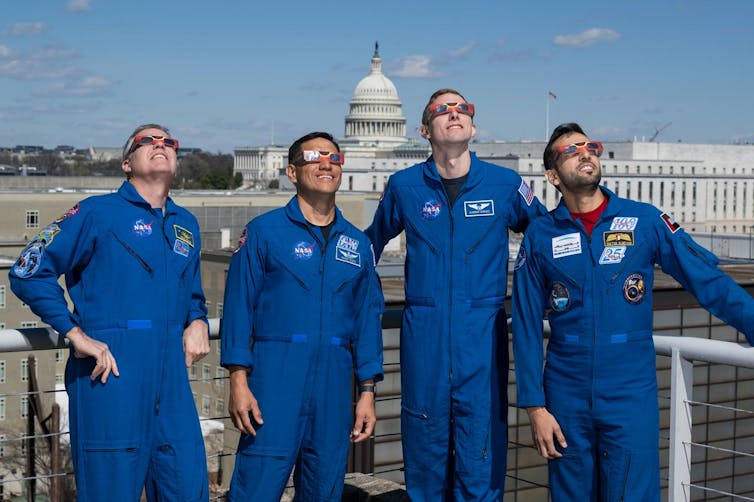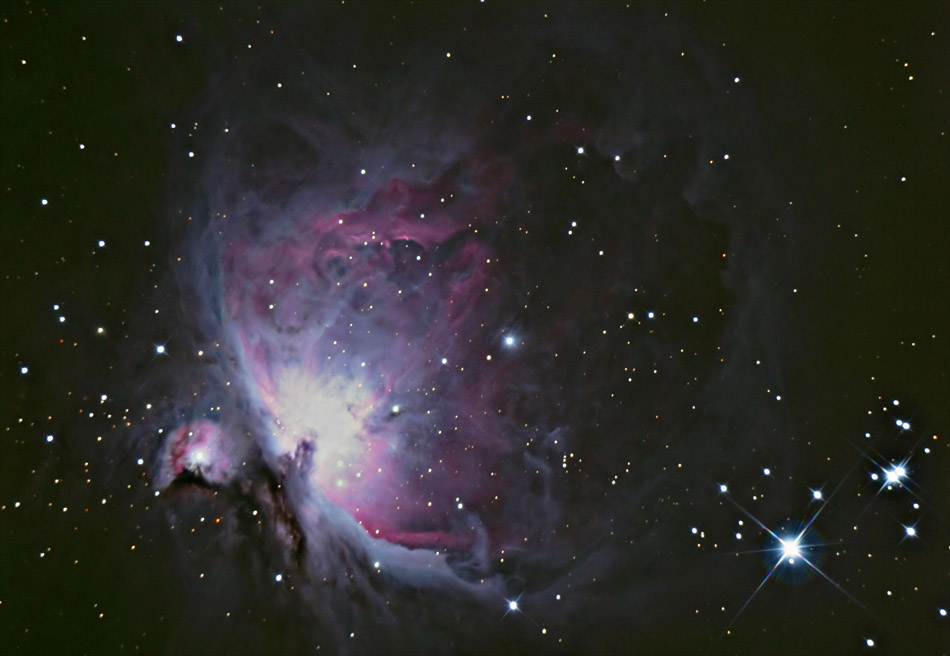
A solar eclipse is a rare and beautiful astronomic phenomenon as the orbiting moon blocks out the sun, making twilight out of a sunny day. A total solar eclipse is even more special, like the one on April 8 that can be observed along a narrow swath of land from Mexico, through the United States and Canada in Niagara, the St. Lawrence valley, New Brunswick, Cape Breton and Newfoundland.
Witnessing a total solar eclipse is a once-in-a-lifetime event, and a spectacle that millions of people think will be worth travelling for. It is certainly worth preparing for, and one key aspect relates to safety: looking at the sun for any length of time can cause damage to your eyes.
Permanent damage
When we look at anything, the lens in our eye focuses the light on the retina at the back of the eye. The retina contains the sensitive cells that turn light into electrical signals sent to our brain, allowing us to see. When we look at the sun at full strength, the amount of light is too much, and these cells can be damaged in a mechanism called solar retinopathy. Your eyes aren’t burned, but the blue light can cause a chemical reaction that can permanently damage the retina.
The sun is not more dangerous during the eclipse — what is dangerous is our curiosity to look at the sun for a longer amount of time. It is remarkable how little sunlight it takes to make looking at the sun uncomfortable. Toronto and Ottawa will have more than 99 per cent of the sun blocked during this eclipse, but even then, it is unsafe to look at the eclipsed sun without protection.
To look directly at a partial solar eclipse safely we need to block almost all the sun’s light. Solar filters — also known as eclipse glasses — are a safe, effective and cheap way to do this. These glasses should conform to the standard ISO 12312-2, which block 99.997 per cent of the light.

This allows you to look at the bright sun — even without an eclipse — without pain or eye damage. These glasses are readily available at many retailers, and some are being donated by libraries and universities in Canada and the United States along the eclipse’s path.
It is strongly recommended to only purchase glasses from certified vendors, such as those listed on this list from the American Astronomical Society.
Safe viewing practices
To use the glasses safely, put them on and then look at the sun. Take them off only when looking away. A great way to prepare for the eclipse is to practice — look at the sun through the glasses before the eclipse.
Don’t use these filters if they appear damaged or scratched. These glasses block so much light that you shouldn’t do anything except look at the sun while wearing them as you will be effectively blind.
Do not look through a telescope or binoculars when wearing the eclipse glasses because they cannot handle the magnified amount of light. Advanced techniques for telescopes and binoculars are needed.
Cameras and cell phones are less prone to damage than our eyes, but they can be damaged by imaging the sun too. A million pictures of the eclipse will be available on the internet April 9 — I recommend just enjoying the experience without your camera.
Small children should be supervised when viewing the eclipse. If the child is too young to follow the instructions above, then you should keep them inside to be perfectly safe.

Indirect watching
If you don’t have certified glasses, there are indirect ways of looking at a partial solar eclipse. A pinhole camera allows the eclipsed sun’s disk to be projected onto a screen using only a cardboard box, a piece of aluminium foil and some tape.
Anything where the sun’s rays pass through a small hole can become a makeshift pinhole camera — the shadow cast by a colander, or the dappled shadow of the leaves of a tree can make beautiful crescent sun images on the ground.
Projecting the sun’s image through binoculars or a telescope onto a sheet of paper is another safe way to watch indirectly, and you may even be able to see sunspots this way.
For those of us fortunate to be in a location where the eclipse is total, you will need to remove the glasses to see the total eclipse because the glasses stop so much light that everything is invisible during totality. You can find out if you are within the path of the total eclipse using various online maps.
You will know when it’s safe to look at the moon blocking the sun when you can no longer see anything in your eclipse glasses or pinhole camera. Totality for this eclipse lasts as little as a few seconds near the edge of the path of the moon’s shadow, up to a maximum of just over three minutes in Niagara.
Eclipse magic
A total eclipse allows us to see the sun’s corona — the wispy tendrils of hot gas that mysteriously extend millions of kilometres from the Sun’s surface — and possibly solar flares or prominences that extend beyond the moon. Take off the glasses and look up to see this, and the sunrise visible all around you, for the few minutes of total eclipse magic.
At the first sign of the sun coming out from behind the moon, look away and return to the pinhole camera or glasses to look at the sun. One great way to know when to take off and put on glasses is to watch with experts — many communities have planned viewing locations with experts interpreting what you are seeing. If the weather is good, crowds watching the eclipse may be large, so be patient and prepared for delays.
The next total solar eclipse in Canada won’t be until 2044, and total eclipses are on average 366 years apart at any one location. The eclipse is worth seeing, so prepare for April 8 and be safe!
Robert Knobel, Associate Professor, Physics, Engineering Physics & Astronomy, Queen’s University, Ontario
This article is republished from The Conversation under a Creative Commons license. Read the original article.










